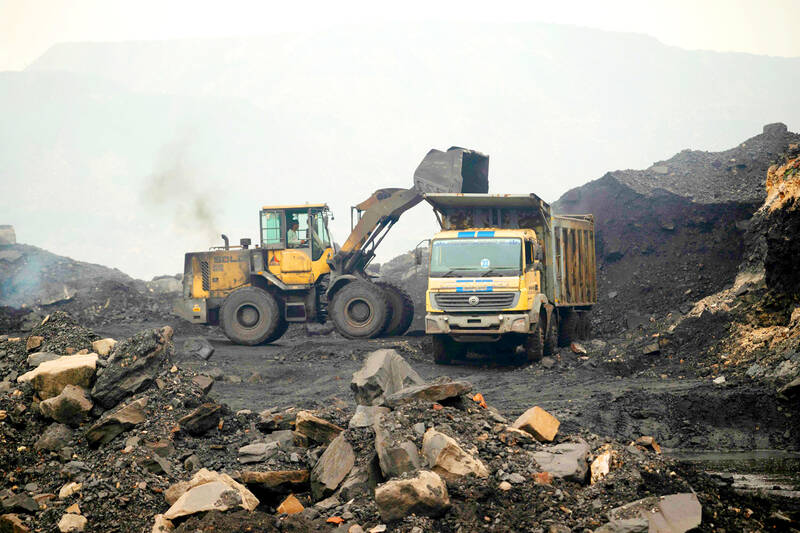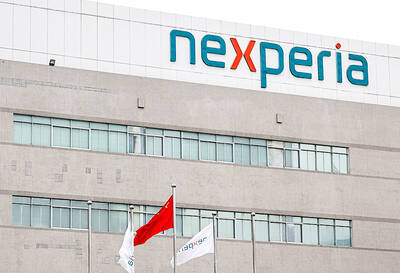Non-fossil fuels now account for half of India’s installed energy capacity — years ahead of schedule — but the third-largest greenhouse gas polluter remains deeply reliant on coal for electricity generation.
“A landmark in India’s energy transition journey,” Indian Minister of Renewable Energy Pralhad Joshi sid after the world’s most populous nation released figures last month.
“Five years early,” he added, referring to India’s 2030 target under the Paris Agreement, and marking a step to the country’s stated goal of reaching net zero emissions by 2070.

Photo: AFP
However, while the 50 percent milestone is significant, climate expert Avantika Goswami said the figures — which refer only to potential energy production — tell just part of the story.
“Overall, actual generation from renewable sources is still quite low,” Goswami said from the New Delhi-based Centre for Science and Environment.
The reason is stark: Nearly three-quarters of electricity continues to come from heavily polluting coal-burning power plants.
The challenge becomes even more apparent when examining India’s continued dependence on coal. Far from decreasing its usage, the globe’s second-largest consumer of coal pushed up production of the dirty fossil fuel by five percent last year, mining 1 billion tonnes, according to the coal ministry.
“Coal remains crucial,” the Indian Ministry of Coal said.
The stance highlights the practical challenges of India’s energy transition. Coal is needed to fulfil power demands while storage capacity lags behind the surge in renewable sources of power.
“The coal sector remains a crucial contributor to India’s energy mix, powering over 74 percent of the country’s electricity and sustaining key industries like steel and cement,” the coal ministry said, celebrating what it dubbed “India’s coal boom.”
This reliance places India in a challenging position globally. The country ranks behind only China and the US for carbon emissions overall.
However, analysts point out that in a country of 1.4 billion people, per capita emissions are only one-third of the global average, according to official figures.
“Looking at India’s per capita emissions, the effort it is making, India is doing pretty well,” said activist Harjeet Singh, head of the Satat Sampada Climate Foundation.
India has set itself the daunting challenge of reducing emissions by 45 percent by 2030.
At the same time, electricity needs are expected to more than double by 2047, according to the country’s Center for Science and Environment.
Supplying some of that demand “is likely to be met by the addition of renewables”, Goswami said.
Half of India’s 484.8GW installed capacity is from non-fossil fuel sources.
The majority comes from solar, totaling 119GW — the third-largest level globally.
India is building one of the world’s largest solar and wind energy farms, spread over a desert the size of Singapore.
It is followed by hydro and wind, and also nuclear power — which makes up less than 2 percent of the total mix.
However, solar and wind create steady power only when the conditions are right, and India’s storage capacity is a meagre 505MWh — far lower than it can generate.
The storage bottleneck was not lost on the renewable energy minister.
Speaking at the inauguration of a battery storage systems plant in June, Joshi said India’s renewable energy potential was “growing fast” and “adding 25-30 GW every year.”
“But without storage, we will either waste that energy or fall back on coal when renewables dip,” he added.
Building storage based on batteries requires rare earth metals, with rival and neighbor China controlling 70 percent of the world’s supplies.
“We still remain dependent on China,” said Harjeet Singh, the climate activist.
Chinese Foreign Minister Wang Yi (王毅) was in New Delhi for talks on Tuesday, with the supply of rare earth metals on the agenda.
One solution India is considering is pump-hydro energy storage projects.
When wind and solar plants produce excess energy, water is pumped into high reservoirs. That stored energy can then be released to generate power when demand surges.
However, Goswami believes the transition to cleaner power requires a multi-pronged approach.
The transition to cleaner power must come from “emission intensity reduction” of often inefficient coal plants, combined with better integrated renewable energy in the grid that “will actually make the shift happen,” he said.

JITTERS: Nexperia has a 20 percent market share for chips powering simpler features such as window controls, and changing supply chains could take years European carmakers are looking into ways to scratch components made with parts from China, spooked by deepening geopolitical spats playing out through chipmaker Nexperia BV and Beijing’s export controls on rare earths. To protect operations from trade ructions, several automakers are pushing major suppliers to find permanent alternatives to Chinese semiconductors, people familiar with the matter said. The industry is considering broader changes to its supply chain to adapt to shifting geopolitics, Europe’s main suppliers lobby CLEPA head Matthias Zink said. “We had some indications already — questions like: ‘How can you supply me without this dependency on China?’” Zink, who also

The number of Taiwanese working in the US rose to a record high of 137,000 last year, driven largely by Taiwan Semiconductor Manufacturing Co’s (TSMC, 台積電) rapid overseas expansion, according to government data released yesterday. A total of 666,000 Taiwanese nationals were employed abroad last year, an increase of 45,000 from 2023 and the highest level since the COVID-19 pandemic, data from the Directorate-General of Budget, Accounting and Statistics (DGBAS) showed. Overseas employment had steadily increased between 2009 and 2019, peaking at 739,000, before plunging to 319,000 in 2021 amid US-China trade tensions, global supply chain shifts, reshoring by Taiwanese companies and

Taiwan Semiconductor Manufacturing Co (TSMC, 台積電) received about NT$147 billion (US$4.71 billion) in subsidies from the US, Japanese, German and Chinese governments over the past two years for its global expansion. Financial data compiled by the world’s largest contract chipmaker showed the company secured NT$4.77 billion in subsidies from the governments in the third quarter, bringing the total for the first three quarters of the year to about NT$71.9 billion. Along with the NT$75.16 billion in financial aid TSMC received last year, the chipmaker obtained NT$147 billion in subsidies in almost two years, the data showed. The subsidies received by its subsidiaries —

At least US$50 million for the freedom of an Emirati sheikh: That is the king’s ransom paid two weeks ago to militants linked to al-Qaeda who are pushing to topple the Malian government and impose Islamic law. Alongside a crippling fuel blockade, the Group for the Support of Islam and Muslims (JNIM) has made kidnapping wealthy foreigners for a ransom a pillar of its strategy of “economic jihad.” Its goal: Oust the junta, which has struggled to contain Mali’s decade-long insurgency since taking power following back-to-back coups in 2020 and 2021, by scaring away investors and paralyzing the west African country’s economy.